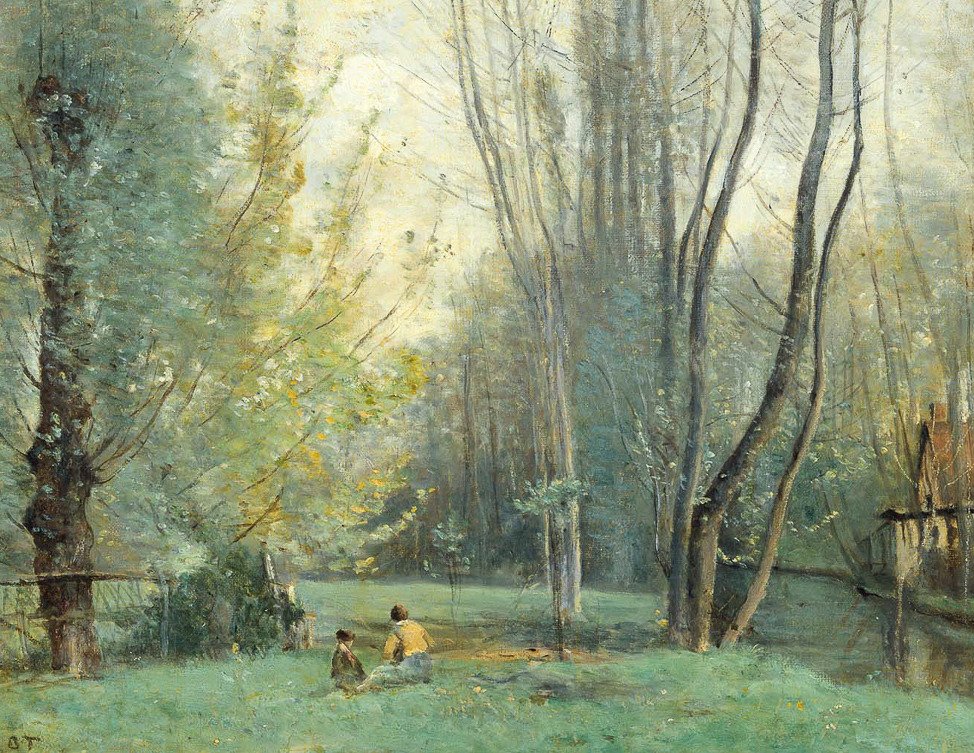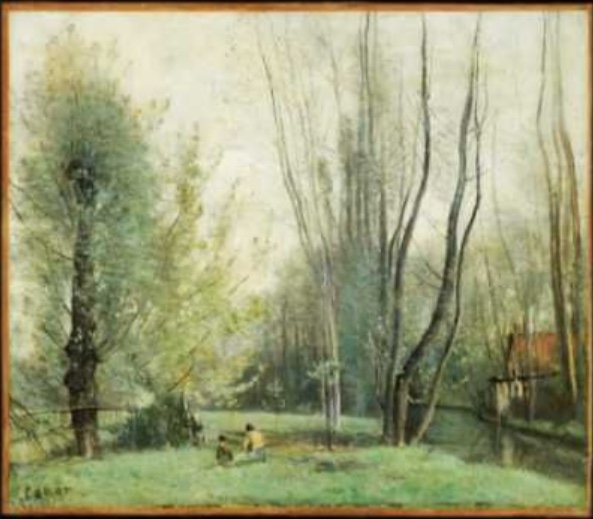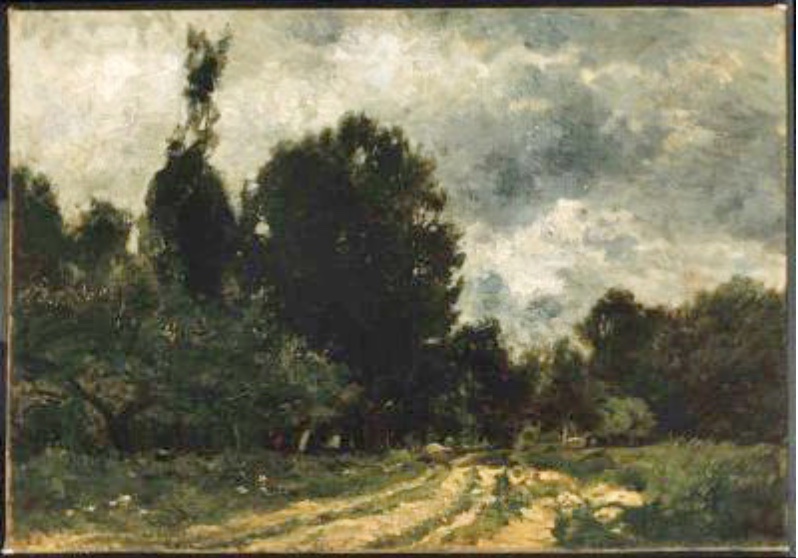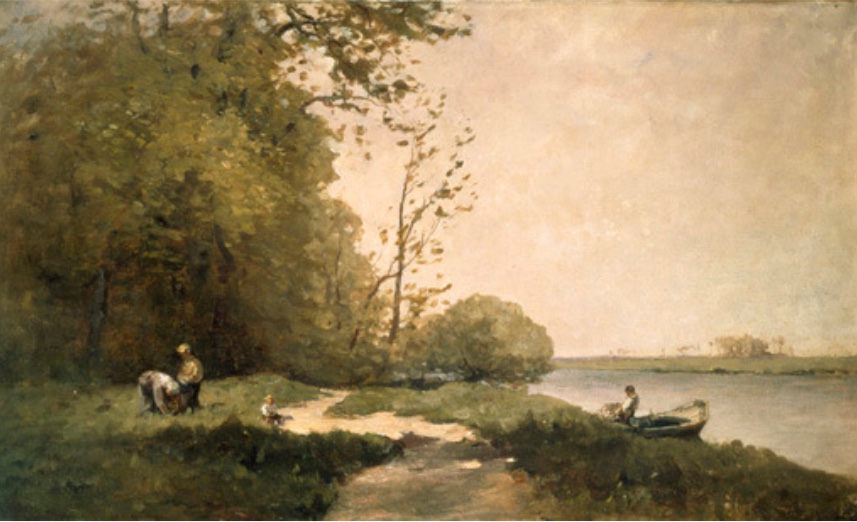
French Naturalism - Pre-Impressionist Art
Classical art had its origins in the Renaissance. In its Neo-Classical revival, it was accepted as almost the official art of the French State under the emperor Louis Napoleon (1852-1871). A great exhibition of approved work known as the Salon was held annually in Paris, the only such exhibition until the Impressionists came on the scene in the late 1860s. The only paintings approved for exhibition at the Salon were history subjects or scenes from mythology, in which work on a large scale, done in 'the Grand Style', was strongly recommended
An example of this type of painting is The Romans of the Decadence (Orsay Museum, Paris) by Thomas Couture. This large painting, 473x 489 cm, portrays an orgy by upper class Romans in a theatrical setting of classical buildings in deep perspective. As we look at this we are supposed to feel shocked at such moral degeneracy at a time when the barbarians were outside the gates, and Rome was about to fall. In addition to its great size and emotional overstatement and technical skill, it is dark-toned, with the emphasis on tone rather than colour. Purporting to represent idealism and perfection, it was the very type of art rejected by the Impressionists as pretentious and overblown. It was of a type of work that had been done ad nauseam.
On the other hand, the Impressionists were concerned with representing the truth of their every-day experience in a much more modest and informal manner. Couture's painting is hung in the main room of the Orsay Museum so that visitors can compare this work with the many Impressionist paintings in the museum.
THE LANDSCAPE TRADITION.
While Impressionism exposed the emptiness of history painting, it did not invalidate the whole of nineteenth-century art. From the middle of the 19th century a number of artists were involved in the revival of a tradition of landscape painting based on sketches done outdoors. In their realistic and fresh approach to landscape, these artists helped to pave the way for the Impressionists who were very much influenced by them. Among these artists were Jean-Francois Millet, Gustave Courbet and J.B.Carot. Although innovative in many respects, in that they painted real landscapes and real people, they were still influenced by classical ideals of clarity, perfect finish and the traditional, idealised L shaped composition. Although realist in their approach to art, they were not realists in the sense of the Impressionists. They painted in the studio from drawings and sketches made outdoors and because they hadn't really begun to observe the colours of nature, they used a lot of brown, and their shadows were painted in black. Their emphasis was on tone rather than colour. Intensive outdoor observation of colours had to wait for the Impressionists.
GOUSTAVE COURBET.
In 1850 Gustave Coutbet shocked the Parisian establishment with monumental pictures of the peasants from his rural homeland. The very size of his paintings was a cause for concern. There was a convention in official art circles that only lofty subject matter - historical or mythological scenes - was appropriate for large-scale depiction. In the case of peasant paintings such as those of Courbet, a more moderate size was expected. In his painting, The Burial at Ornans, 1850 (Orsay Museum, Paris) which depicted a group of people at a country funeral, Courbet was saying that his friends and neighbours in Ornans, although poor and backward, were just as worthy of glorification as the heroes of past history. For the members of the official academy of art in Paris it was an offence to hold up ordinary folk as ideals for consideration. To these people, paintings of vulgar, unidealised peasants, portrayed on a heroic scale, were interpreted as threatening political statements.
Courbet, a democrat, came to be regarded by the authoritarian government under Louis Napoleon as a dangerous revolutionary, if only because through his art, he was now saying that the common man was worthy of heroic status.
Courbet showed the harsh reality of peasant life. He painted people as he saw them, without sentimentality. There is nothing idealised in Burial at Ornans. It is a dark, tonal painting that expresses the sadness of the occasion. The dominant colour is brown. The small areas of bright colour - red and white - draw the eye to important parts of the picture, leading to the priest and the chief mourners. The background is broken by the town of Ornans on the left and the crucifix and the line of cliffs on the right. Courbet applied his paint very thickly in order to capture the rugged appearance of the country folk and rejected the smooth finish of the official art of his time.
In this painting he is not concerned with deep perspective as in classical art but forces the eye to linger on the surface of the canvas as it moves across the line of figures.
J. B. CAROT.
Carot was less revolutionary in his approach than Courbet. Unlike Courbet, he did not paint real people in real life situations. His break with tradition was in painting landscapes from sketches made outdoors. Although his subject matter was new, his approach was still founded on the classical ideal. For him, drawing and clarity of line was still very important, and there is more emphasis on tone than colour. Colours are muted. Shadows are painted in black and brown. His pictures have perfect finish. Surfaces are painted smoothly with soft brushes. His composition is the traditional L shape. His is an ordered, static and tranquil world - very much the classical ideal. His paintings have a gentle, poetic quality.
Woman Reading on a Wooded Bank (private collection).
In addition to the above characteristics it is well to note the inclusion of the figure, not as a result of observation, but as a focal point or centre of interest and painted with a few touches of contrasting red to attract the eye. The Impressionists would have included a real person in the picture. The boat is also part of the centre of interest because of its black tones contrasted with the pale water. Where the sky and water are painted smoothly, the Impressionists would have used choppy brushstrokes. The distant parts of the landscape have the same clarity of line as the foreground. In an Impressionist painting the background would have a softer line, making the picture more atmospheric. Where the Impressionists observed a greater variety of colours in the landscape and paler greys in the background, Carot's foreground, distant hill and trees are all exactly in the same green. The Impressionists would also have described the form of the foreground tree in colours rather than tones. Their colour scheme would have been more varied. Compare this painting with The Red Roofs by Camille Pissarro. The composition is beautifully balanced between the large trees on the left and the distant trees on the right, whereas Impressionist compositions might place less emphasis on order. A characteristic of many of Carot's paintings is a gentleness created by his soft line and feathery finish to the various plants. His paintings have a lyrical quality undimmed by time.
Morning near Beauvais, 1860. Fine Arts Museum, Boston.
This is one of Carot's later paintings. It was painted near the city of Beauvais, sixty-five kilometres northwest of Paris.
Carot's vision was one of security and stability (the Classical ideal), reflecting the prevailing mood in mid to late 19th century France, still a predominantly rural country. Everything in this painting is a revelation of this vision - the harmony of closely related colours, the balance between open and carefully confined space, in the stable vertical orientation effected by the trees, and in the human presence, so perfectly at ease.

Compared with Woman Reading on a Wooded Bank, the colour is a little more varied. The colours are mainly green, yellow, brown and a touch of red, the whole tending towards monochrome. As with all of Carot's work, the emphasis is on tone rather than colour. The human presence, (this time, two figures), directs our attention to the foreground and middle ground, where the artist creates a sense of intimacy, security and well-being in the fresh air and soft light of early spring.
Carot creates an atmosphere of serene calm and tranquillity by emphasising the vertical linearity of the scene, especially in the vertical lines of the bare trees on the right, which lift the eyes literally to the heavens. The tall trees in the foreground establish a sense of space when contrasted with the smaller trees in the distance. The composition thus establishes a sense of confined space where the woman and child can feel protected and safe as they rest on the grass, flanked by the trees. The house on the right further adds to the sense of security. This painting is a fine example of Carot's late lyricism.
The Gust of Wind. 1867. Musee Des Beaux-Arts, Rheims.
This is one of Carot’s rare portrayals of nature in movement. The picture is an example of his soft blue and silvery greens – typical muted, monochromatic pre-impressionistic colour. The figure is not from observation but merely included to provide a centre of interest and to lend scale to the landscape. The colour is almost monochrome.
JEAN FRANCOIS MILLET 1814-1875.
Millet was born in the small rural community of Gruchy in Normandy. He studied art in Cherbourg and later in Paris where he lived for some time before returning to Cherbourg to continue his career as an artist. In one sense he never left his rural roots and the country he loved.
Vineyard Labourer Resting. 1870, (Museum Mesdag, The Hague. Exhibited in Amsterdam). The medium is pastel and black conte crayon on paper.
Millet has often been criticised for idealising rural labour in such images as the much reproduced The Angelus. Vineyard Labourer, Resting, on the other hand, presents a more realistic image of backbreaking labour in rural France in the 19th century. Here, his labourer is left slumped on the ground, gasping for air. He has seemingly merged with the very earth which he has been cultivating. The rich green colours of the vines and the warm yellows and browns of the worker and the soil at once shelter and overwhelm him – a convincing representation of physical exhaustion. Good for a response in creative writing.
Man with a Hoe. 1863. The J. Paul Getty Museum, Los Angeles.
In an undated letter, Millet wrote as follows. “In the cultivated places, although at times in regions hardly at all tillable, you see figures spading and hoeing; you see one, from time to time straighten up his back...and wipe his forehead with the back of his hand. You will eat your bread with the sweat of your brow. Is that the gay jolly work which certain people would have you believe? It is nonetheless there that I find true humanity, the great poetry.”
The figure in this painting couldn’t be more far removed from the classical ideals of perfection. This is a depiction of raw, earthy realism. Millet empathised with the rural labourer toiling in the fields and in so doing he has invested the man with heroic qualities.
A deeply sunburned peasant, while leaning awkwardly on the handle of a heavy hoe, his ankles collapsing under his weight, tries to straighten himself up to breathe. The bottoms of his trousers are scuffed and muddy. The clay ground he has been breaking up is stony, and strewn with weeds and brambles. As he tries to get a breath of air, his mouth sags open and he stares vacantly ahead. There was no one who equalled Millet in his depiction of what he described as the “infinite glories” of the country, but his main concern was the people and horses labouring in the fields. In this picture he is contrasting the large-scale commercialized farming – seen in the far distance – with the local workers it left unemployed and marginalized. Yet it is the toiling peasant he places centre stage in his composition.
Note the freedom with which the foreground rocks and plants are rendered, the contrast between the earthen foreground and the yellow fields in the distance and the effect of sunlight reflected on the man’s sleeves.
Millet’s painting is open to a political interpretation, in the sense that the artist was highlighting the conditions of the rural poor in late 19th century France. Much of French literature considered such types as in Man with the Hoe as the “brute” representing the rural norm at that time. Many Parisians- mostly in official circles be it said, were morbidly preoccupied at the prospect of hordes of rural poor descending on the streets of Paris demanding radical change. However it was most unlikely that such characters as the man with the hoe would suddenly appear in the boulevards of Paris with hoe and sickle in hand, threatening the upper classes.
CHARLES FRANCOIS DAUBIGNY.
Carot, Daubigny and Millet were three members of a group of French artists who took up residence in the village of Barbizon near the forest of Fontainebleau, some thirty miles south of Paris in the middle of the 19th century. They became known as the Barbizon painters. They were to influence the future course of French art up to the time of the Impressionists. They were the first to share the common belief of working in the open air and painting subjects from real life, both landscapes and figures in the landscape. This was a major break from the so-called history painting (see Romans of the Decadence) still recognised as the only valid type of art in the Parisian art establishment.
Road through the Forest 1865-70. Fine Arts Museum, Boston.
This painting is revolutionary in its subject matter, in its sketchy unfinished character and broken brushstrokes. However, in its muted, dark tones, in the use of black in the shadows and in its clearly defined areas of light and shade, it has all the hallmarks of a pre-Impressionist painting in the Classical style. Compare with any painting by Monet.

NATHANIEL HONE THE YOUNGER (1831-1917).
Nathaniel Hone the Younger was the first Irish painter to introduce French Naturalism into Irish Art. Trained first as an engineer, he headed off to Paris in 1853 to study art. After four years studying and copying works of the great masters in the Lourve he settled in Barbizon in the Forest of Fontainebleau near Paris where there was a school of landscape painting known as the Barbizon painters. Here he met all the French artists who had gathered there – Carot, Courbet, Millet and Daubigny. Hone met some of the Impressionists but the Barbizon school was his main influence.
His painting, On the Banks of the Seine shows the influence of the Barbizon School and can be compared with Daubignny’s Road through the Forest, in its emphasis on tone, its textures and the use of black in the shadows.

